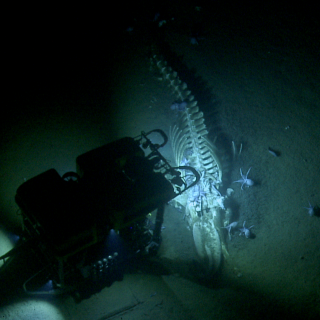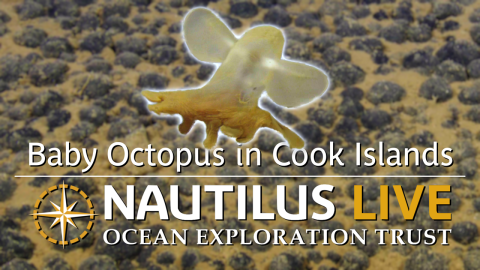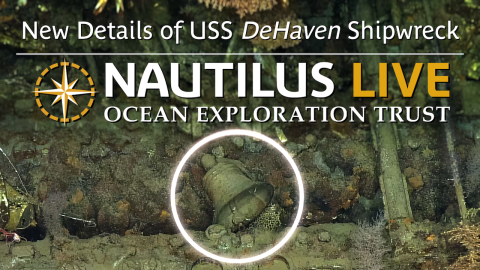Octopus Wonderland: Return to the Davidson Seamount
Our return to the Monterey Bay “Octopus Garden” revealed the ever-changing wonders of this deep-sea octopod nursery.
Diving at a depth of over 3100 meters (10,000 feet) in the Monterey Bay National Marine Sanctuary near Davidson Seamount, we once again found hundreds of brooding octopods meticulously caring for their offspring. One very active brooding octopus was for the first time caught-on-camera as she was seen actively laying and cementing her eggs to the rock.
“This may be the first time we’ve seen one actually actively cementing her eggs to the rock,” explained Lead Scientist Chad King. “They have something similar to a salivary gland and they produce this oviducal cement — it’s like an underwater cement and they can attach the base of the stalk of the egg directly to the rock.”
That theory is furthered by the fact that she’s not in the inverted position, her mouth is down, our observation of her carrying an egg through her arms.
A closer look at the ROV Hercules footage reveals the shimmering waters of the deep, which indicate an outpouring of hot water from now-inactive geological and hydrothermal features believed to be the result of a pressure differential in a low temperature ridge-flank hydrothermal system connected to Davidson Seamount as the source, 12 kilometers (7.5 miles) to the northwest. It is thought that these warmer waters provide necessary habitat to deep-sea octopus communities and may bring vital nutrients necessary to the successful production of offspring in an otherwise inhospitable seascape.
Our exploration continued two miles deep in the ocean where temperatures are near freezing, 0 degrees Celsius or 32 degrees Fahrenheit. While in this region, we took temperatures and dissolved oxygen measurements and found that the ambient temperature of the seawater was around 1.7 degrees Celsius (35 degrees Fahrenheit), but jumped to more than 7 degrees Celsius (44 degrees Fahrenheit) near the shimmering outpours – that’s an almost six-degree jump! Our warmest reading in the garden clocked in at 10.4 degrees Celsius (50 degrees Fahrenheit), an aptly named octopus “hot tub.”
Every so often, the Corps of Exploration spotted an octopus that was not in the breeding posture. In these cases, we try to look closely at the structure of the arms — a male octopus has a slightly different arm structure than a female — and observe other unique behaviors, such as the male-female couple we saw “courting” one another.
In 2018, our team first discovered more than a thousand deep-sea octopods in never-before-seen aggregations. Most incredibly, nearly all of the octopuses were females resting in the brooding position, tucked into rocks with their eight arms facing out to cover their bodies and precious eggs. The periwinkle-hued octopuses are believed to be Muusoctopus robustus, though our team is awaiting DNA results to confirm this. Since we first discovered the “Octopus Garden,” marine scientists have conducted several dives in the region and have observed developments of baby octopuses inside their eggs and multiple hatchlings. This means this rocky outcrop could be an important nursery to deep-sea octopuses!

Central California NMS
This joint expedition will visit three distinct areas of Monterey Bay National Marine Sanctuary (MBNMS), a region comprising one of the world’s most productive and biologically rich ocean areas protecting over 700 species of fish and deep benthic species. Pioneer Canyon is in the northern portion of MBNMS, and is administered by Greater Farallones National Marine Sanctuary.



